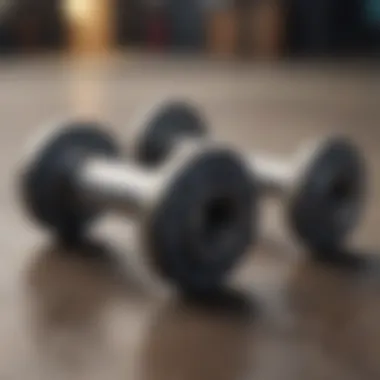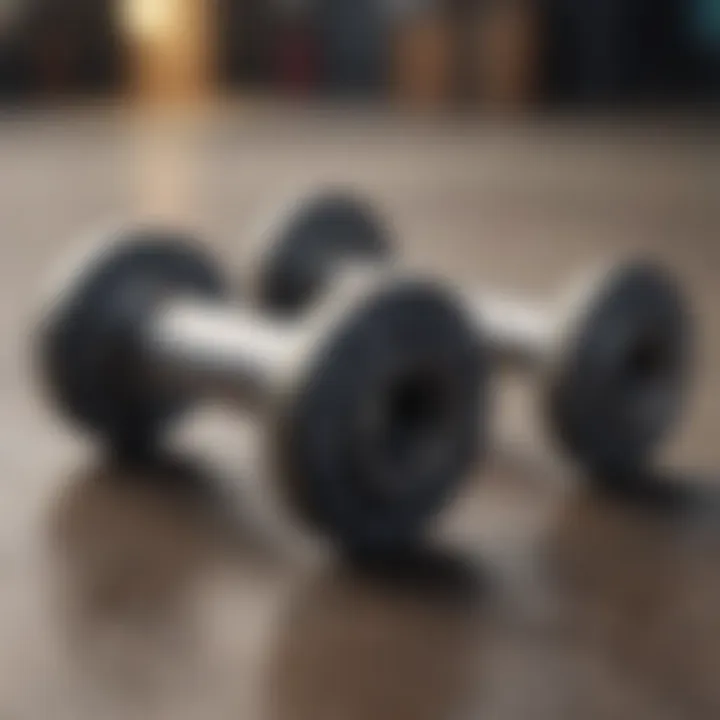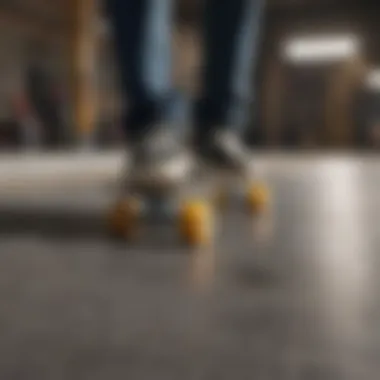Skateboard Truck Spacers: Design and Performance Insights


Intro
Skateboarding is more than just a pastime; it’s an expression of individuality and an adrenaline-fueled adventure. One often overlooked element that can make or break a riding experience is the spacer in a skateboard truck. You might be wondering, what even is a spacer? To put it simply, spacers are small cylindrical inserts placed between the bearings in skateboard wheels and the trucks. Yet, these little components hold the key to improve ride quality and customize maneuverability.
Importance of Spacers
Many skaters, especially beginners, might not realize the substantial impact spacers have on their setup. Ignoring these details is like trying to bake a cake without measuring the ingredients—results will vary wildly. Spacers ensure that wheels rotate freely, which can drastically affect speed and control. Picking the right spacers isn’t merely a technical choice; it’s about enhancing your overall skateboard performance.
Understanding Truck Spacers
To really appreciate how spacers work, it is essential to know their anatomy and functions. Skateboard trucks support the skateboard deck and provide stability during tricks. The spacers allow the bearings to sit correctly, preventing unwanted friction and wear, which can lead to poor performance.
Materials Used in Spacers
Spacers may be made from a range of materials. Commonly used ones include:
- Aluminum: Lightweight and durable, aluminum spacers resist corrosion and are preferred by many skaters.
- Plastic: Affordable and effective, plastic spacers often come standard with cheaper setups but could wear down faster.
- Steel: Rarely used due to extra weight, steel spacers offer durability but typically pull down the overall performance.
Different materials offer varying levels of performance depending on your skating style and preferences. This could greatly influence your riding experience, often without riders even realizing it.
Sizes and Compatibility
The size of spacers is another crucial factor to consider. Most spacers come in standard sizes, which generally work well with most skateboard setups. However, a mismatch can lead to issues like wobbly wheels or insufficient spacing between bearing surfaces. Using spacers that fit your wheel and truck setup can mean the difference between a smooth ride and an annoying squeak at every turn.
In this comprehensive guide, we will further review how spacers affect performance, investigate user preferences, and delve into the basic setup configurations that can best work for your style of skating.
Performance Impact
Ultimately, the goal of spacers is to optimize how your skateboard performs. The right choice can lead to improved speed, greater control, and even easier trick execution. A poorly chosen setup, however, might yield subpar outcomes that can frustrate even the most seasoned skaters.
It's crucial to remember that skateboarding is a personal sport. What works best for someone else may not suit your riding style or preferences. The connection between spacers and overall performance cannot be overstated—it’s the compounding effect of every small decision leading to better rides.
"In skateboarding, every detail counts. It’s not just about having a board; it’s about how that board feels under your feet."
As we progress through this guide, we will explore more aspects surrounding spacers and their role in enhancing your overall skateboarding experience.
Prologue to Skateboard Truck Spacers
Understanding skateboard truck spacers is crucial for anyone looking to enhance their skating experience. These little pieces of hardware often get overlooked in discussions about skateboards, yet they play a pivotal role in the overall setup of a board. Proper spacers can better align your wheels with the trucks, ensuring that you get a smoother ride. Let’s look deeper into what makes spacers significant.
Defining Truck Spacers
Truck spacers are small cylindrical pieces, often made of metal or plastic, that fit between the skateboard’s wheel and its truck. Their primary purpose is to maintain the right spacing between the wheel and the truck during rotation. Without them, you might encounter issues like wheel bite, which occurs when the wheel comes into contact with the board while turning sharply. This can lead to wobbles or even tumbles if you're going fast.
Spacers come in various sizes and materials, which can affect not only the feel of the ride but also the overall longevity of the components they support. Thus, choosing the right spacer is not just about aesthetic; it’s about performance too.
The Role of Spacers in Skateboarding
Spacers wield significant influence over your skateboard's performance. They ensure even weight distribution across the wheels, which is essential for achieving a balanced ride. When skateboarders perform tricks or ride aggressively, the stress on wheel and truck alignment becomes more pronounced. Here, spacers help keep everything in line, minimizing friction and wear.
Additionally, as a skater hones their style, they might find that adjusting or swapping spacers can lead to different feels underfoot. Some prefer a tighter setup for stability, while others might lean towards a looser configuration for greater maneuverability. These elements transform how the skateboard responds under various conditions, whether you're cruising down the street or hitting the skatepark doing tricks.
“The smallest components often yield the biggest benefits. Neglecting spacers could mean sacrificing performance.”
In summary, the significance of skateboard truck spacers cannot be overstated. They are the unsung heroes that contribute to a skater's control, stability, and overall experience on the board.
The Anatomy of Skateboard Truck Spacers
Understanding the anatomy of skateboard truck spacers is crucial for anyone serious about their skating experience. Spacers act as a bridge between your skateboard trucks and wheel assemblies, enhancing performance through improved alignment, control, and durability. Let’s dive deeper into the materials they are made from and the common sizes available.
Materials Used
Metal


Metal spacers are typically crafted from aluminum or steel, making them quite strong and durable. The key characteristic of metal spacers is their robustness, and they are often favored among professional skaters who rely on their setup to withstand high-impact tricks. A unique feature of metal is its ability to offer relatively low weight without sacrificing performance. However, a disadvantage could be their susceptibility to rust if not cared for properly, especially in humid conditions, which means skaters must be mindful of maintenance.
Plastic
Plastic spacers, on the other hand, are a more affordable alternative that many skaters opt for, especially beginners. They are typically made from high-density polyethene which makes them lightweight. The beneficial attribute of plastic spacers is their flexibility, which can actually help absorb shock during landings. However, a downside might be their lower durability compared to metal options. In time, they can wear down faster, impacting performance.
Composite
Composite spacers combine the strengths of both metal and plastic, striving for a balance between weight and durability. The key characteristic of composites is their resilience; they can resist wear better than plastic while maintaining a lightweight profile. Their unique edge lies in the ability to customize formulas based on skater preferences, making them a popular choice among those seeking tailored setups. Yet, the higher cost can deter some skaters from opting for composite materials.
Common Sizes and Specifications
Standard Dimensions
When it comes to skateboard truck spacers, standard dimensions generally cater to a wide audience. Typically, spacers for standard trucks come in sizes such as 8mm for axle width. The key characteristic of standard dimensions is their universality; they fit most setups and are easy to find. One of the advantages of using standard sizes is the interoperability with many truck brands, ensuring skaters can easily replace or upgrade their spacers without hassle. However, a potential drawback is that standard sizes might not suit all riding styles or personal preferences, leading to compromise in performance.
Custom Sizes
Custom sizes are ideal for skaters looking to enhance their setups based on specific requirements. The key attribute of custom sizes is their adaptability; they can be tailored to fit unique wheel sizes or specific board profiles. This customization can significantly enhance performance by allowing skaters to achieve their desired ride height or wheel clearance. However, sourcing custom sizes may entail a longer wait time and potentially higher costs, which might not be ideal for all skaters.
By understanding these elements of skateboard truck spacers, skaters can make more informed decisions about their equipment, ultimately leading to a more enjoyable experience on the board.
How Spacers Affect Skateboard Performance
Understanding how spacers influence skateboard performance can be a game-changer for both novices and seasoned skaters. These small yet significant components are not just accessories; they play a crucial role in the functionality and feel of your skateboard. Spacers impact ride height, stability, control, and even wheel clearance. Here, we’ll break down each of these elements in depth.
Influence on Ride Height
Ride height refers to the distance between the ground and the skateboard deck. Spacers can directly influence this measurement. When you insert spacers between the trucks and the deck, you have the ability to effectively raise or lower the skateboard. A higher ride allows for better clearance over obstacles, which can be especially beneficial for skaters performing tricks that require more air, such as ollies and kickflips.
On the flip side, lowering the ride height can enhance stability, particularly for technical or street skating where precision is key. It feels almost like being closer to the ground gives skaters more control over their board. With the right height, skaters can achieve a balance between maneuverability and stability according to their skating style. The general rule of thumb is to opt for spacers that fit your personal preferences while considering the type of skating you engage in.
Impact on Stability and Control
Stability and control are at the heart of any skater's performance. The right spacers can make or break your ride in this regard. Spacers that are too thick can lead to an unnaturally high center of gravity, resulting in a wobbly feel that’s hard to manage at high speeds. Alternatively, using spacers that enhance stability can instill confidence, especially when navigating parks or performing tricks.
Additionally, a well-aligned setup provides better weight distribution across the skateboard. This contributes to improved maneuverability during turns and tricks, which can drastically affect overall performance. The interplay between the trucks, wheels, and spacers is vital to achieving this balance.
Spacers typically allow for a snug fit between the wheel and the truck, reducing play. This snugness further enhances how well the board responds to skate-dependent movements—faster response means a smoother ride.
Effect on Wheel Clearance
Wheel clearance is another area where spacers have notable effects. The distance between the skateboard deck and the wheels, also known as wheel clearance, determines whether you experience wheel bite. Wheel bite occurs when the wheel gets so close to the deck that it locks up, often resulting in a fall.
Using spacers to adjust the height of the trucks can prevent these mishaps. For example, beginners who are still learning might benefit from a little extra height to safeguard against the dreaded wheel bite. On the other hand, advanced skaters often prefer tighter setups that allow for quick turns without risking drag. Therefore, finding that sweet spot in wheel spacing is essential, especially during tricks.
"The margin between making a trick and wiping out often comes down to wheel clearance. Get it right, and you can push your limits. Get it wrong, and it's game over."
Installing Spacers: Best Practices
When it comes to achieving the best performance out of your skateboard, the installation of truck spacers plays a key role. Properly installed spacers contribute greatly to alignment, wheel clearance, and, ultimately, your ride experience. Missteps during installation can lead to noise, wobbling, and even injuries. So, focusing on the best practices for installng spacers isn’t just a minor detail; it’s a crucial part of your setup.
Preparation and Tools Needed
Before you dive headfirst into the installation process, it's vital to gather the necessary tools and prepare adequately. The right preparation can save you time and headaches down the road. Below is a checklist to help you get started:
- Skateboard Setup: Your complete skateboard assembly with trucks attached.
- Spacer Tools: Wrench or socket set, preferably adjustable, to suit various nut sizes.
- Cleaning Supplies: A cloth or paper towels for removing dirt and grime.
- Lubricant: Some skateboarders prefer a little grease to ease the installation, but be cautious with its application.
- Safety Gear: Though redundant, using safety goggles might be a smart choice to protect your eyes from debris during the installation.
Having these items within reach before you begin can make a world of difference.
Step-by-Step Installation Process
Once you're prepped and ready, it’s time to get your hands dirty. Following a systematic approach helps make sure everything goes smoothly. Here’s a step-by-step guide:


- Remove the Wheels: Using the wrench or socket, carefully loosen and remove the nuts from each wheel. Set them aside carefully to avoid losing parts.
- Inspect the Spacers: Check both the spacers and trucks for any signs of wear or contamination. If everything looks good, you can proceed.
- Slide the Spacers into Place: Place the spacers on the axle between the bearings and the truck. Ensure they sit flush against the truck face without any gaps — if they're off, it could spell trouble.
- Reattach the Wheels: Carefully place the wheels back over the bearings and spacers. Take your time to assess alignment.
- Tighten the Nuts: Use the wrench to secure the nuts onto the hub, but don’t go overboard! Too tight can crush your bearings, while too loose can lead to wobbles.
- Final Check: Spin your wheels manually to make sure there’s no friction or unusual noise. It should rotate smoothly.
With everything done right, you should expect improved performance from your skateboard.
Common Mistakes to Avoid
Even seasoned skaters might slip up when installing spacers. Here are some pitfalls to steer clear of:
- Skipping Inspections: Before you begin, it’s tempting to jump right in. Always double-check your spacers and truck before installng.
- Over-tightening: This is a common catch. Over-tightening can damage the bearings or even cause the spacers to crack.
- Ignoring Cleanliness: Dirt or debris between the spacer and the truck can hinder performance. A clean surface is vital for good installation.
- Rushing the Process: Take your time. Rushing can lead to mistakes that can affect your ride quality.
Selecting the Right Spacer for Your Setup
Choosing the right spacer for your setup is crucial, as it significantly affects your overall skateboard performance. Spacers are not just mere accessories; they play a central role in how your board handles and feels while riding. Understanding the nuances of spacer selection can help in maximizing your skateboarding experience, ensuring both safety and style.
Understanding Your Skate Style
When it comes to selecting a spacer, the first element to consider is your skate style. Skaters have different approaches—they might be cruising around, participating in street skating, or pulling tricks in a skate park. Each style has its demands, and the appropriate spacers can enhance or hinder your performance depending on how you skate.
For instance, if you're into technical street skating, you might want a lower ride height to maintain stability during trick executions. Opting for smaller spacers or none at all can lower your center of gravity, giving you better control. Conversely, if you enjoy going downhill at high speeds, having a taller setup with larger spacers could provide extra stability and handling.
Considering Board Type and Size
A skateboard isn’t just one-size-fits-all, and neither are spacers. The type and size of the board you ride will dictate what spacers are suitable. For instance, if you've got a wider deck, you might find that high-profile spacers allow for larger wheels. This encourages better tuns and smoother rides, especially over rough surfaces.
On the other hand, if your board is more narrow, high-profile spacers may create a wobbly ride. It’s best to measure your board and wheels carefully before making a decision. Being aware of how those dimensions interact with the spacers is key to avoiding unwanted issues, such as wheel bite, where the wheel touches the board during turns.
Choosing Between High and Low Profiles
Finally, deciding between high and low profile spacers plays an essential part in your setup. High-profile spacers allow for larger wheels, which can glide over obstacles better, improving your overall ride. This could be ideal for skaters who love hitting the park or skate street features.
Low-profile spacers, however, lower your ride and, as mentioned before, provide more stability during technical tricks. This sometimes gives the rider a more connected feel to the board—a crucial aspect for many serious athletes.
It's essential to balance all these factors: your skating style, the type of board you use, and the profile of spacers to achieve the best possible setup that suits your needs.
In summary, selecting the right spacer is an intricate process that involves understanding your skating habits and equipment. It’s advisable to experiment with different combinations to find the perfect fit for your unique style, which ultimately leads to an enhanced skating experience.
Maintenance and Care of Skateboard Truck Spacers
Proper maintenance of skateboard truck spacers is crucial for optimizing performance and prolonging the lifespan of both the spacers and the skateboard itself. Just as you wouldn't neglect the upkeep of your car, your skateboard deserves the same level of attention. If spacers begin to wear out or accumulate dirt and grime, it can negatively affect your ride, leading to inefficiency and maintaining a consistent performance can be a real game-changer.
Cleaning Techniques
Keeping spacers clean isn't as complicated as it sounds. Simply removing dirt and dust can do wonders. Here are some straightforward techniques:
- Use a Soft Cloth: Start by wiping down the surface of your spacers with a microfiber cloth. This helps to remove any surface dust.
- Water and Soap Solution: If you encounter more stubborn grime, mix a small amount of dish soap in water. Soak the cloth in the solution and gently clean the spacers. Remember not to soak them too much, as excessive moisture can seep into the inner workings.
- Use a Toothbrush: For those harder-to-reach areas, a soft-bristled toothbrush can be quite handy. Just a few gentle strokes can dislodge unwanted dirt.
Avoid using harsh chemicals or abrasive materials that can scratch or damage the spacers. Treat them like finer pieces of equipment and you'll reap the rewards.
Checking for Wear and Tear
Just like keeping an eye on your board and trucks, spacers need regular inspection to ensure they are in good condition. Here’s what to look for:
- Cracks or Deformations: Check for any visible cracks or signs of bending. If you spot any damage, it’s worth considering a replacement.
- Surface Roughness: Rub your fingers along the edges and surface. If they feel rough or uneven, it indicates wear that could impact how the wheels interact with the trucks.
- Free Movement: Ensure that spacers can move freely without sticking. A spacer that’s stagnant can cause unwanted friction, ultimately altering your ride.
Frequent checks, particularly after heavy use, can help to prevent nasty surprises during a session at the park.
When to Replace Spacers
Knowing when to replace your skateboard truck spacers can save you from headaches down the line. Here are indicators that it might be time:
- Visible Damage: If you’ve spotted cracks or any significant wear, don’t put off replacing them—it's not worth the risk.
- Loss of Performance: If you feel that your skateboard isn’t rolling smoothly or there’s an unusual wobble, check your spacers. They may be causing issues.
- Increased Noise: If your ride has gotten louder, it might be the spacers. Noises can hint at wear and are often an indicator for inspection.
Once you determine that replacement is necessary, don’t hesitate. A quick swap can get you back to the exhilarating ride you cherish.


"Neglecting maintenance can lead to bigger issues down the road. Staying on top of your spacers makes riding safer and more enjoyable."
By maintaining and caring for skateboard truck spacers, you’re putting yourself in the best position to enjoy a smooth ride while ensuring your gear stays in top-notch shape.
Case Studies: Real-World Experiences
In this part, we dig into firsthand accounts from both professional skateboarders and dedicated hobbyists. These real-world experiences shine a light on the practical implications of skateboard truck spacers, allowing us to see beyond the theoretical aspects into the grit of daily skating life. Each anecdote reveals unique perspectives that highlight why spacers matter. Riders with varying skills, styles, and preferences provide invaluable insights into how the right spacers can transform a skateboard setup.
Professional Skateboarders' Preferences
When it comes to skateboard truck spacers, professionals often treat these components like secret weapons in their arsenal. Top-tier skaters tend to prefer spacers that match their specific riding style and focus on performance metrics.
For instance, some professional athletes argue that tighter spacers lead to increased control and precision during technical tricks. They often favor aluminum spacers for minimal weight and sturdiness. A few elite skateboarders have even custom-designed their spacers to perfectly fit their trucks and wheels. This customization helps to optimize everything from flick stability to landing consistency.
"It's like the difference between night and day; the right spacers can change how you land that trick you've been working on for ages."
— A professional skateboarder on spacer significance
Additionally, we see professionals often switching spacers based on the event or competition they're participating in. More challenging terrains may call for thicker or different materials, while street skating may lean towards lighter products that facilitate more flipping and maneuvering. This fluid choice underscores the importance of spacers in high-stakes environments, where performance can make or break a ride.
Enthusiast Feedback and Insights
Skateboard enthusiasts, often riding for the sheer joy of the sport, also share their insights into the advantages spacers bring to their skating experience. Many amateur skaters stress the importance of alignment and balance, noting that the right spacer helps maintain a consistent distance between the wheels and the trucks, reducing the risk of wheel bite.
Feedback from these riders often features stories about their early experiences in skateboarding, where improper use of spacers led to awkward rides and uncomfortable falls. As they grew more knowledgeable, they began experimenting. This experimentation led to personalized setups that align with their preferences.
Some common insights:
- Tuning Experience: Enthusiasts appreciate the tuning aspect of spacers. Many have found that tweaking spacer sizes led to noticeable changes in ride comfort and stability.
- Budget Choices: Most believe that quality doesn't always come with a hefty price tag. Some say they found excellent results with plastic spacers as they provide a smoother ride for less money.
- Social Aspect: Beyond performance, the social circle around skating often shares information and experiences related to spacers, showing how community fosters growth and knowledge within the sport.
In summary, both professionals and skaters pursuing leisure find that the vital role of spacers is backed by experienced observations and personal preferences. Thus, the collective knowledge gathered through these case studies serves as invaluable guidance for anyone looking to upgrade their skateboard setup.
The Future of Skateboard Truck Spacers
The significance of skateboard truck spacers in the evolving landscape of skating cannot be overstated. These seemingly simple components play a vital role in how boards function, making their future developments quite crucial. Shifts in user preferences, technological advancements, and innovative materials aim to enhance the performance traits that skaters value most. Looking ahead at what’s on the horizon helps enthusiasts understand where the industry is headed and how their own setups may benefit.
Innovations in Design and Materials
As new technologies seep into the skateboarding world, spacers are not left behind. There’s a growing focus on materials that not only reduce weight but enhance durability. For instance, lightweight alloys such as aerospace-grade aluminum are making waves in spacer design, providing a great blend of resilience and agility. This means you can now enjoy longer skate sessions without worrying about the constant wear and tear.
Additionally, the emergence of advanced composites allows for flexible designs that can absorb impacts better than traditional metals. This can lead to a smoother ride, especially when hitting gaps or maneuvering tough parks. With better shock absorption, skaters can maintain higher speeds over rough surfaces, allowing them to push their skills beyond limits.
Another trend is the use of 3D printing, making custom spacers easily accessible. Skaters can tailor their spacers to suit individual needs, whether they’re aiming for a specific height or weight distribution. This customization factor not only enhances the player's experience, but also creates a sense of personal attachment to their gear.
Emerging Trends Among Skaters
With the skateboarding community continuously evolving, trends signal a shift in how skaters interact with their gear. A notable trend is the rise of eco-friendliness in materials used for spacers and trucks. Nowadays, a good chunk of skaters are environmentally conscious and want to make responsible choices. This means manufacturers are crafting spacers from recycled materials or bio-based products. Not only is this sustainable, but it also sparks a conversation about the direction of extreme sports in an age of climate awareness.
Alongside sustainability is the influence of online communities like those on platforms such as Reddit and Facebook. Skaters are discussing and sharing their experiences, allowing information about new developments to spread like wildfire. As a result, there’s a solid movement towards more conscious purchasing decisions among skaters, highlighting a preference for brands that prioritize innovation and ethics.
"Skaters today are not just buyers; they're strategists seeking gear that resonates with their values."
In summary, the future of skateboard truck spacers is bright, full of innovation and shifts in user preference. From materials that promise resilience and sustainability to the unique trends arising from community engagement, understanding these elements can greatly enhance one’s skating experience. The importance lies not just in the components themselves, but in how these advancements will translate into better performance, durability, and an overall enjoyable ride for both seasoned skaters and newcomers alike.
Ending: The Importance of Spacers in Skateboarding
In the world of skateboarding, the focus often lands on flashy tricks, impressive boards, or the sheer thrill of the ride. However, tucked away in the shadows are crucial components that can make or break the riding experience: spacers. As we wrap up this in-depth exploration, it's imperative to highlight the significance of spacers in the overall functionality and performance of skateboard trucks.
Spacers serve a critical function by providing support and stability to the skateboard’s setup. When wheels are mounted, spacers fill the gap between the bearings and the axle nuts, ensuring that everything fits snugly. This not only minimizes the risk of wobbling during high-speed sessions but also enhances control, allowing riders to execute tricks with precision.
Moreover, spacers play an instrumental role when it comes to ride height and wheel clearance. A proper spacer choice affects how your skateboard handles obstacles and maneuvers. For example, if you’re looking for stability in your skateboarding, utilizing spacers that fit your style can give you that extra edge.
Recap of Key Points
- Functionality: Spacers create a secure fit between wheels and bearings.
- Stability and Control: Proper spacers contribute to the stability of your ride and enhance overall control during tricks.
- Customized Height: They allow for variations in ride height and wheel clearance, catering to different skate styles and preferences.
- Wear and Durability: Regular maintenance and proper selection can prolong the lifespan of spacers, ensuring an optimal riding experience.
"A well-placed spacer could be the difference between a tedious ride and one that feels just right."
Encouragement for Informed Choices
As we close this guide, it’s essential for skateboard enthusiasts, whether beginners or seasoned pros, to make informed decisions about spacers. Understanding the nuances of how spacers interact within your setup can vastly improve your overall skating experience. Don't just pick a spacer because it's popular or looks good; consider your skating style, the type of tricks you aim to perform, and the dimensions of your board.
Investing time to research and select the right spacers may take a bit of effort, but the payoff is undeniably worth it. Take advantage of online forums or platforms like Reddit and Facebook where skaters share their experiences. Every skater has a unique journey and learning from their trials can help you find what might work best for your own setup.







